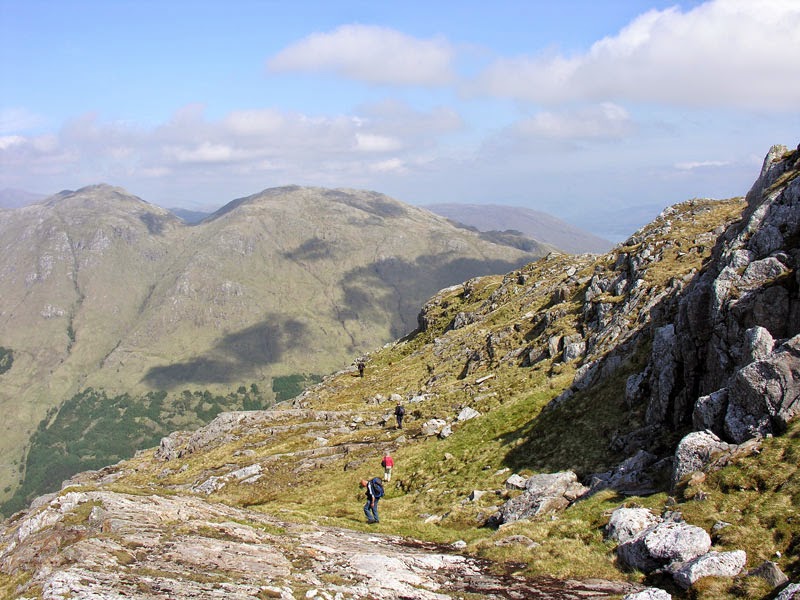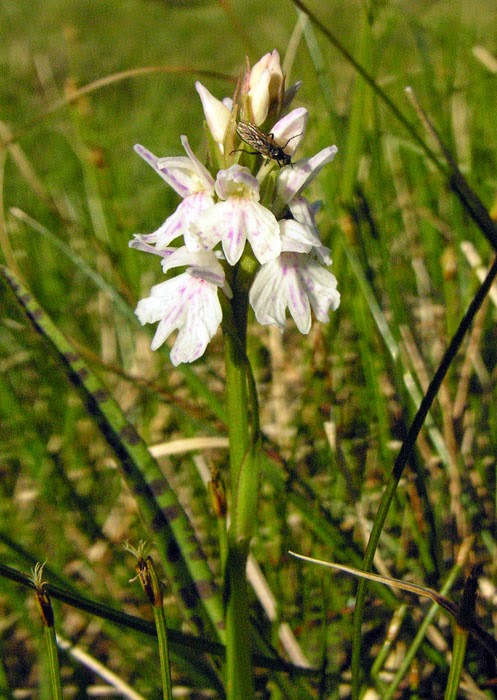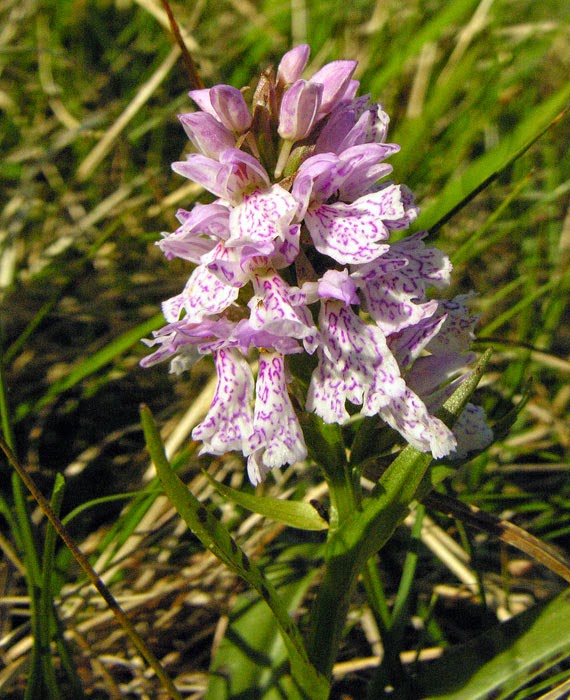This guest blogpost is rather a departure from News &
Views' usual style: it features an American, rather than a British or Irish,
botanist and has some serious footnotes. But after I noticed Siobhan Leachman enthusing
on Twitter about a female botanist I had never heard of, I simply had to ask
her to tell us more. Siobhan very kindly agreed and the result is presented
here.
 |
| Dudleya collomiae Image: Mr Alan English CPA Reproduced by kind permission of Mr English |
I was surprised at the number of women botanists and plant collectors mentioned by him given he was writing in the early 1900’s. One of the women frequently noted was Rose E. Collom.
Rose Collom nee Wilson was born in Georgia and had trained as a teacher2, attending Lindenwood College in 1886-87 and 1888-893. She became interested in Arizona flora when she moved to the State with her husband W. B. Collom in 1914. They lived in an isolated area in Gila County in the foothills of the Mazatzal Mountains where her husband worked a mine on the Collom property.
Plant
Collecting
An
article in the Arizona Producer quotes her as stating “I thought I
would go crazy at first. My husband spent his days working the mine;
beyond cooking his meals and mending his clothes there was nothing
for me to do except sit … and gaze out over these hills”. Collom
was unintimidated by the “coyotes yelping on the ridges or a
mountain lion screaming up the canyon”. She began to take long
walks and study the unique plants from the area.4
 |
| Mazatzal Mountains Image: Mr Alan English CPA Reproduced by kind permission of Mr English |
Her
plant collecting led her to discover several plants previously
unknown to science that would eventually to be named after her. Among
these are Dudleya collomiae6
(Gila County liveforever), Ranunculus collomiae and Galium collomiae.
Dr. John Thomas Howell of the California Academy of Sciences,
when naming Galium collomiae wrote, “It is a pleasure and honor to
name this distinctive addition to the Arizona flora in honor of Mrs.
Rose Collom who has done so much critical field work in that state”.7
Her
collected specimens are held in numerous Herbarium including the U.S.
National Herbarium, the Lois Porter Earle Herbarium at the Desert
Botanical Garden and the Arizona State University Herbarium.8
Other institutions that hold her specimens include the Royal
Botanical Gardens, Kew, the Rancho Santa Ana Botanic Garden,
Lindenwood University Herbarium and the Grand Canyon Museum Herbarium
which holds the Rose Collom Collection.9
Collaboration
with other notable Botanists
 |
| Rose Collom, botanist Image: Grand Canyon National Park Museum Collection #5284 Reproduced by kind permission of the Museum |
“Flowering
Plants and Ferns of Arizona” became the foundation upon which
Kearney & Peebles based their later book “Arizona Flora”.
Collom also contributed to “Arizona Flora” and its subsequent
amendment. Arizona Flora remained the best and most comprehensive
reference guide to Arizona plants for over 30 years.11
First
Paid Botanist of the Grand Canyon National Park
Rose
E Collom also became the Grand Canyon National Park’s first paid
botanist from 1939 until 1954.12
In June of 1938 Collom collected in the Grand Canyon and in October
exchanged letters with Mr E. McKee, the cofounder of the Grand Canyon
Natural History Association (the forerunner to the Grand Canyon
Association). He offered her a grant to enable her to collect
specimens in the Grand Canyon area. In accepting this grant she
became the first paid botanist of the Grand Canyon National Park.13
She
conducted her botanical work at the Park, visiting to collect
specimens or work in the herbarium, every year except 1948. The
herbarium at the Grand Canyon National Park has 826 of her
specimens.14
Garden
Clubs and Botanical Societies
Mrs
Collom was also active with the Arizona Federation of Garden Clubs.
She was the Horticultural Chairman of the Federation of Garden Clubs
of Arizona15
and helped to encourage the use of native Arizona plants for
landscaping in home gardens and highways.16
She
believed that some plants from higher altitudes could adapt
themselves to lower altitudes if they were planted and cared for at
an intermediate level and had time to accommodate themselves to the
changed conditions. She was encouraged in this theory of progressive
adaptation by Dr J. J. Thornberry, a botanist at the University of
Arizona and Dr F. J. Crider, Director of the Boyce Thompson
Arboretum. She put this theory into practice by collecting plants
from higher altitude and then allowing them several seasons to adapt
to intermediate conditions in her garden before replanting at a lower
altitude.17
Mrs
Collom was also a member of the Arizona Cactus and Native Flora
Society, which in 1937, founded the Desert Botanical Garden in
Phoenix. She was a charter member of the Desert Botanical Garden18
and supplied numerous native Arizona plants to it.19
Her valuable personal herbarium collection along with her
writings were donated to the Desert Botanical Garden in 1951.20
Conclusion
The
influence of Rose Collom in the field of botany was posthumously
recognised when she was inducted into the Arizona Women’s Hall of
Fame in 2013.21
Her collection work continues to assist scientists today as her
specimens are studied and cited in academic journals".22
Many thanks to Siobhan for this fascinating account and for the excellent list of references below, which are worthy of New Journal of Botany (I can give no higher praise!).
1
Smithsonian
Institute, Smithsonian
Digital Volunteers: Transcription Centre,
available at: https://transcription.si.edu/
(accessed 20th
January 2015)
2
Arizona
Producer (1930), “Woman of the Wilderness”, Arizona
Producer,
September 15, p. 4
3
Lindenwood
College Bulletin, (1930), “Woman of the Wilderness”, Lindenwood
College Bulletin,
Vol. 104, No.6, p. 10
4
Arizona
Producer (1930), “Woman of the Wilderness”, Arizona
Producer,
September 15, p. 4
5
Arizona
Women’s Hall of Fame (2013), Rose Collom (1870 – 1956) available
at:
https://www.azwhf.org/inductions/inducted-women/rose-collom-1870-1956/
(accessed 5th
January 2015)
6
Gentry,
Mary A. (1982), “Woman Botanists and Plant Collectors of Arizona”,
Central
Arizona Cactus and Succulent Society Newsletter, The Central Spine,
Vol. 2, No. 4, p. 2
7
Howell, J.
T., (1949), “Three New Arizona Plants”, Leaflets
of Western Botany,
Vol. 5, No. 9, p. 151
8
Gentry, Mary A. (1982), “Woman Botanists and
Plant Collectors of Arizona”, Central
Arizona Cactus and Succulent Society Newsletter, The Central Spine,
Vol. 2, No. 4, p. 2
9
National Park Service, Grand
Canyon Museum Collection, available
at: http://www.nps.gov/grca/historyculture/muscol.htm
(accessed 20th
January 2015)
10
Kearney,
T. H., Peebles, R. H. and Collaborators (1942), Flowering
Plants and Ferns of Arizona,
United States Department of Agriculture Misc. Publication No. 423,
Washington DC. p. 3
11
University of Arizona Herbarium, Arizona
Floras and Floristic Works, available at:
http://ag.arizona.edu/herbarium/resources/books/floristic_az
(accessed 5th
January 2015)
12
Arizona Women’s Hall of Fame (2013), Rose
Collom (1870 – 1956) available at :
https://www.azwhf.org/inductions/inducted-women/rose-collom-1870-1956/
(accessed 5th
January 2015)
13
Spendens, F. [pseudonym of Quartaroli, R. D.]
(2013), “Grand Canyon’s Other Rose and First Botanist” Grand
Canyon River Runner, Spring, No.
15, p. 12 -13
14
Spendens, F. [pseudonym of Quartaroli, R. D.]
(2013), “Grand Canyon’s Other Rose and First Botanist” Grand
Canyon River Runner, Spring, No.
15, p. 12 -13
15
Tucson
Daily Citizen,
March 16th
1944, p. 8
16
Gentry,
Mary A. (1982), “Woman Botanists and Plant Collectors of Arizona”,
Central
Arizona Cactus and Succulent Society Newsletter, The Central Spine,
Vol. 2, No. 4, p. 2
17
Arizona
Producer (1930), “Woman of the Wilderness”, Arizona
Producer,
September 15, p. 4
18
Hodgson W. and Salywon, A., (2014) “Desert Botanical Garden
Herbarium (DES) Phoenix”, The
Plant Press, Arizona Native Plant Society,
Vol. 37, No. 1, p. 8.
19
Arizona
Independent Republic,
February 20th 1940, p. 6
20
Gentry,
Mary A. (1982), “Woman Botanists and Plant Collectors of Arizona”,
Central
Arizona Cactus and Succulent Society Newsletter, The Central Spine,
Vol. 2, No. 4, p. 2
21
Spendens,
F. [pseudonym of Quartaroli, R. D.] (2013), “Grand Canyon’s
Other Rose and First Botanist” Grand
Canyon River Runner,
No. 15, p. 13




.jpg)






